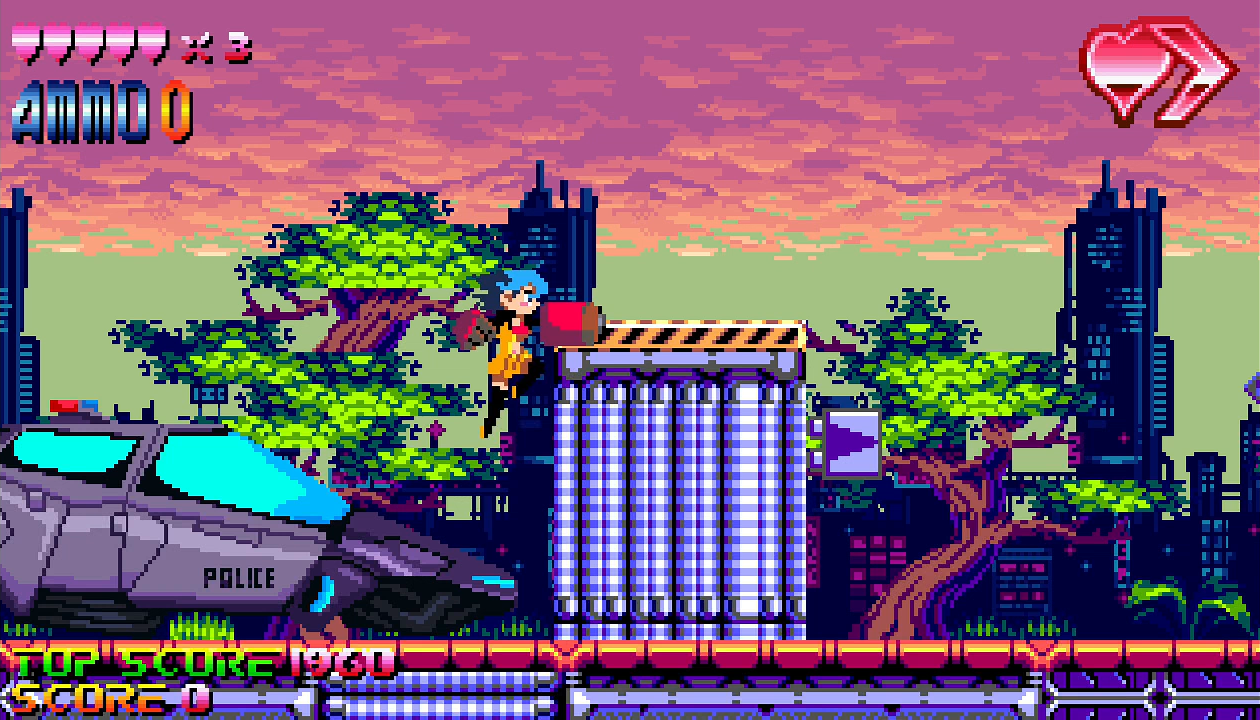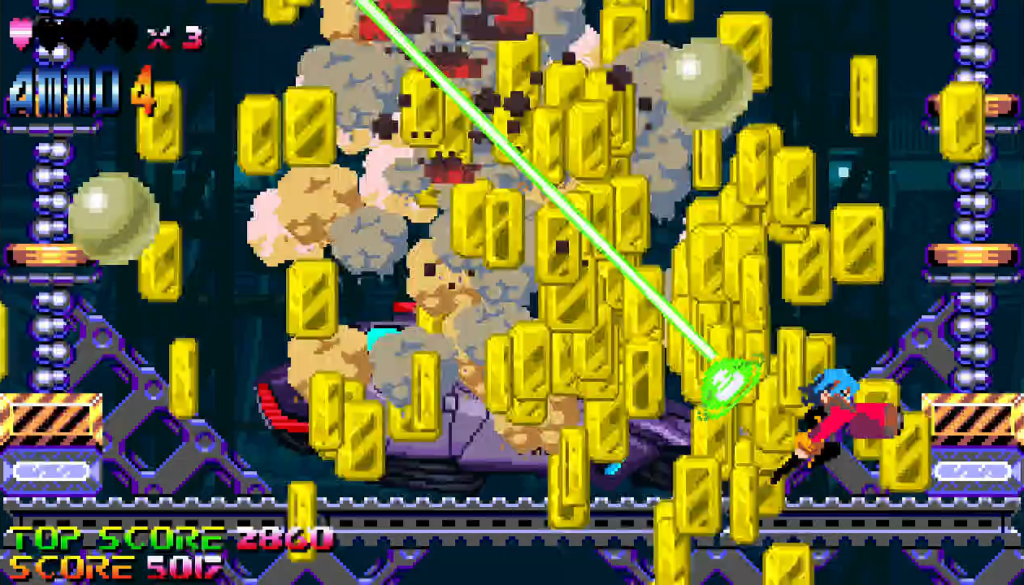I don’t know how to begin describing Gun Crazy. It’s a side-scrolling, arcade-style shooter. That much is clear from the start. But there is no prologue. The first level’s introduction does not trouble itself with explaining the situation. After I beat Gun Crazy, I sit on its title screen for five minutes, hoping a short scene might play that could explain the chaos I just experienced. There is none.

I don’t know the player character’s name. I don’t know their occupation. I don’t know why they are the person who resolves the conflict. They burst onto each level in a police hovercar, jumping out to run through a vaguely futuristic environment while shooting and punching everything that gets in their way—mostly robots, drones, and tanks, with the odd bright-green alien baddie to make things interesting. I don’t believe the player character is a cop; their bright pink crop top and neon yellow parachute pants clash with the drab grey uniform coloring of their police vehicle. A cop car is seemingly how they get around. Maybe they’re on a mission from God.
Gun Crazy is a videogame displaced in time. It reminds me most of the 16-bit arcade-style videogames on the Sega Genesis. These videogames often had stories, but didn’t trouble themselves with communicating those stories to the player. Details about the plot and characters could be discerned from context as often as they couldn’t. If I wanted to know anything about a videogame’s story, I would need its manual, and in that golden era of secondhand stores and recyclable packaging, we were lucky to still have the manual. As a digitally-distributed videogame without a manual, I have no choice but to be content with Gun Crazy being an inexplicable enigma.

Mechanically, Gun Crazy plays like the arcade shooters it resembles. The player character is equipped with weapons on each of their hands: A blaster on their right, and an enormous gauntlet on their left. They can use the gauntlet in melee range to deliver an instant-kill, Metal Slug-style, to any enemy in close range. The problem is if I’ve let an enemy get that close, the player character is probably in trouble. A swing of the fist is a sign of my failure. My goal is to shoot the bevy of enemies that approach from every angle before they can reach the player character all while dodging and weaving through a barrage of hostile gunfire.
There is more to Gun Crazy than running, punching, and shooting. At first I have difficulty understanding this because, as with the story, there is no effort made to explain its mechanical subtleties. This is unfortunate. Once I discover these extra wrinkles I come to regard Gun Crazy with more esteem.

Dotted throughout each level are different powerups that change the projectiles fired by the player character’s blaster. By default, it fires regular bursts of energy. These fire at a slower rate than the powered-up projectiles and their range doesn’t quite reach the far edge of the screen. The different colored powerups serve as tantalizing bursts of strength. There are different colors and varieties, but which one I get doesn’t make much difference. All of them fire faster and further than the basic weapon, decimating every enemy their projectiles come into contact with.
The trouble is these powerups all come with limited ammunition. It’s easy to burst through their supplies in a few seconds. But Gun Crazy hides a mechanic that remedies this ammunition problem. The player character’s last power is to dash to the left and right, passing invincibly through enemy projectiles that get in their way. What Gun Crazy doesn’t tell me is that dashing through these projectiles replenishes the player character’s ammo supply. Once I get into the habit of letting enemies put out a few bullets before eliminating them, the resulting bounty of ammunition gained from dashing through those bullets allows a powered-up gun to last an entire level.

Learning to absorb enemy projectiles and add them to the player character’s supplies is the point where Gun Crazy goes from a difficult shooter to a rather easy one. This is where I begin to notice how it is structured.
Gun Crazy is, in a word, random. There are only four levels which can be completed in about twenty minutes. The first level is set in a garden backdropped by the silhouette of a futuristic city. The second level moves to a giant elevator—how did we get on an elevator? Where is it going? These are not questions Gun Crazy is interested in answering even through implication. The third perches the player character on the roof of their hovercar as it races through a tunnel. The fourth level is a rehash of the first, but with the cityscape in the background replaced by ominous rings bathed in green shadows.

There are six bosses total. The first half are fought in the first level alone. The remaining three levels have only one boss each. The concluding boss to the first, third, and fourth levels are the same boss, albeit differently colored and with different firing patterns. The second level is the only one to have a unique concluding boss.
The way Gun Crazy’s levels are put together does not feel like a coherent videogame. It feels like a collection of vague ideas put together without a sense of escalating tension or difficulty. They’re spaces in which enemies exist to be shot and, my skill permitting, for the player character to run far enough to the right for a boss battle to happen. When the boss is destroyed, we move to the next level. Some of the levels exist to be genre cliches. I would not be shocked to see elevator or tunnel chase levels in a Sega Genesis videogame. This is why these levels are here. They do not justify themselves and they do not try to.

Along with its non-dynamic structure, Gun Crazy is visually confusing. The first level is the worst offender, with the background sometimes shifting to harsh, metal hexagons supporting beams. Most of these metal objects can be run past, except for a few ramps. These ramps appear as decorative as the rest of the metal fixtures, but are actually part of the level geography. This is impossible to tell at a glance. The barren second, third, and fourth levels are almost a welcome reprieve from the first level’s geographic confusion. Almost.
What I do have to contend with on every level is what happens when enemies are destroyed by the player character’s gunfire. They explode, releasing a swarm of bright yellow gems which whirl through the air then converge on the player character, pumping up their point total. Every single defeated enemy releases this swarm. For dense enemy packs, the screen becomes so full of swirling yellow point gems that it becomes much more difficult to discern important details like where enemies and their projectiles are positioned.

The visual confusion caused by these gem tornados makes the second level the hardest one. It is filled with spherical enemies who jump around the screen and divide into smaller enemies when they are shot. Each time they divide, they release the gem swarm. I suffer my most unfair deaths here as it is impossible not to be hit by things I cannot see beneath the swirling yellow vortex.
Gun Crazy’s mechanic of intercepting enemy bullets and adding them to the player character’s own stock of ammunition is the foundation for a great videogame. The execution of everything else holds it back, beginning with how it doesn’t even bother to explain its best feature to me. It’s a short videogame—it can be beaten in about twenty minutes once I know what I’m doing. Learning what I’m doing itself takes me about another twenty minutes. I’ve played great short videogames, but they are bolstered by being delightfully replayable thanks to solid structure and interesting visuals. Gun Crazy is structurally incoherent and a visual mess. I can’t recommend it at any price.